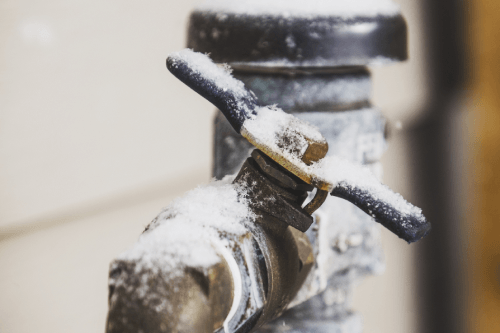How to Prevent Frozen Plumbing in Winter: Pro Advice
How to Prevent Frozen Plumbing in Winter: Pro Advice
Blog Article
We've stumbled on this article relating to 6 Ways to Prevent Frozen Pipes down the page on the internet and reckoned it made good sense to relate it with you in this article.

Cold weather can ruin your plumbing, specifically by freezing pipes. Below's exactly how to prevent it from occurring and what to do if it does.
Introduction
As temperature levels drop, the danger of icy pipes rises, potentially causing costly repair services and water damages. Recognizing how to avoid icy pipes is important for homeowners in cold environments.
Avoidance Tips
Shielding susceptible pipes
Cover pipes in insulation sleeves or utilize warm tape to shield them from freezing temperature levels. Focus on pipes in unheated or outside areas of the home.
Heating methods
Maintain indoor areas adequately heated up, particularly locations with plumbing. Open cupboard doors to allow warm air to circulate around pipes under sinks.
How to recognize frozen pipelines
Try to find reduced water flow from faucets, uncommon odors or sounds from pipes, and noticeable frost on revealed pipelines.
Long-Term Solutions
Structural changes
Consider rerouting pipes away from outside wall surfaces or unheated locations. Add extra insulation to attics, cellars, and crawl spaces.
Updating insulation
Purchase high-quality insulation for pipelines, attic rooms, and walls. Proper insulation aids preserve consistent temperature levels and minimizes the risk of icy pipes.
Safeguarding Outdoor Pipes
Garden tubes and outdoor taps
Disconnect and drain pipes garden pipes before winter season. Mount frost-proof spigots or cover outside taps with insulated caps.
Recognizing Icy Pipes
What triggers pipelines to freeze?
Pipes freeze when revealed to temperature levels below 32 ° F (0 ° C) for extended periods. As water inside the pipes ices up, it increases, taxing the pipeline wall surfaces and possibly causing them to burst.
Dangers and damages
Frozen pipes can result in water system interruptions, property damages, and pricey fixings. Ruptured pipelines can flooding homes and create extensive architectural damages.
Indications of Frozen Pipeline
Identifying icy pipelines early can prevent them from rupturing.
What to Do If Your Pipes Freeze
Immediate activities to take
If you believe frozen pipes, maintain taps open up to ease stress as the ice thaws. Utilize a hairdryer or towels taken in warm water to thaw pipes gradually.
Conclusion
Protecting against frozen pipelines needs aggressive steps and fast reactions. By recognizing the reasons, signs, and safety nets, homeowners can safeguard their pipes throughout cold weather.
6 Proven Ways to Prevent Frozen Pipes and Protect Your Home
Disconnect and Drain Garden Hoses
Before winter arrives, start by disconnecting your garden hoses and draining any remaining water. Close the shut-off valves that supply outdoor hose bibs and leave the outdoor faucet open to allow any residual water to drain. For extra protection, consider using faucet covers throughout the colder months. It’s also important to drain water from any sprinkler supply lines following the manufacturer’s directions.
Insulate Exposed Pipes
Insulating your pipes is an effective way to prevent freezing. Pipe insulation is readily available at home improvement stores and is relatively inexpensive. Pay close attention to pipes in unheated areas such as the attic, basement, crawl spaces, or garage. Apply foam insulation generously to create a buffer against the cold. You can also wrap your pipes in heat tape or thermostat-controlled heat cables for added warmth.
Seal Air Leaks
Inspect your home for any cracks or openings that could let in cold air. Seal any holes around the piping in interior or exterior walls, as well as the sill plates where your home rests on its foundation. Additionally, make sure to keep your garage door closed unless you’re entering or exiting. Leaving it open creates a significant air leak that can lead to frozen pipes.
Allow Warm Air Circulation
During cold snaps, it’s essential to allow warm air to circulate evenly throughout your home. Leave interior doors ajar to promote better airflow. Open kitchen and bathroom cabinets to help distribute heat consistently around the rooms. If you have small children or pets, be sure to remove any household chemicals or potentially harmful cleaners from open cabinets for safety.
Let Faucets Drip
A small trickle of water can make a big difference in preventing ice formation inside your pipes. When temperatures drop significantly, start a drip of water from all faucets served by exposed pipes. This continuous flow helps prevent the water from freezing. Additionally, running a few faucets slightly can relieve pressure inside the pipes, reducing the chances of a rupture if the water inside does freeze.
https://choateshvac.com/6-proven-ways-to-prevent-frozen-pipes-and-protect-your-home/

We hope you enjoyed our article about Preventing and dealing with frozen pipes. Thanks a ton for taking the time to browse our posting. Liked our piece? Please quickly share it. Help somebody else check it out. Thank you so much for taking the time to read it.
Book Instantly Report this page